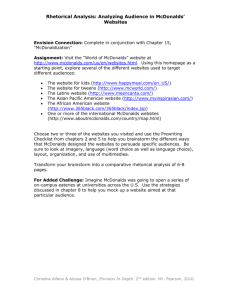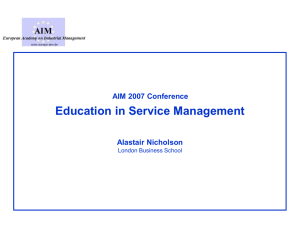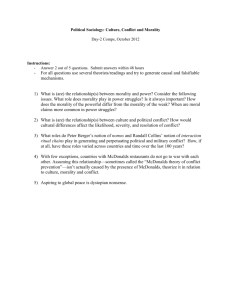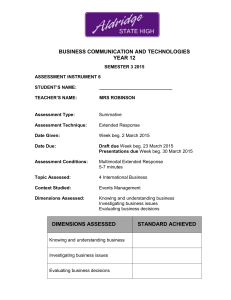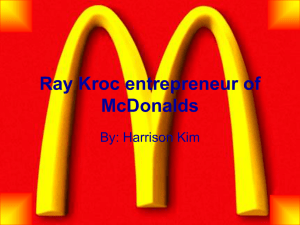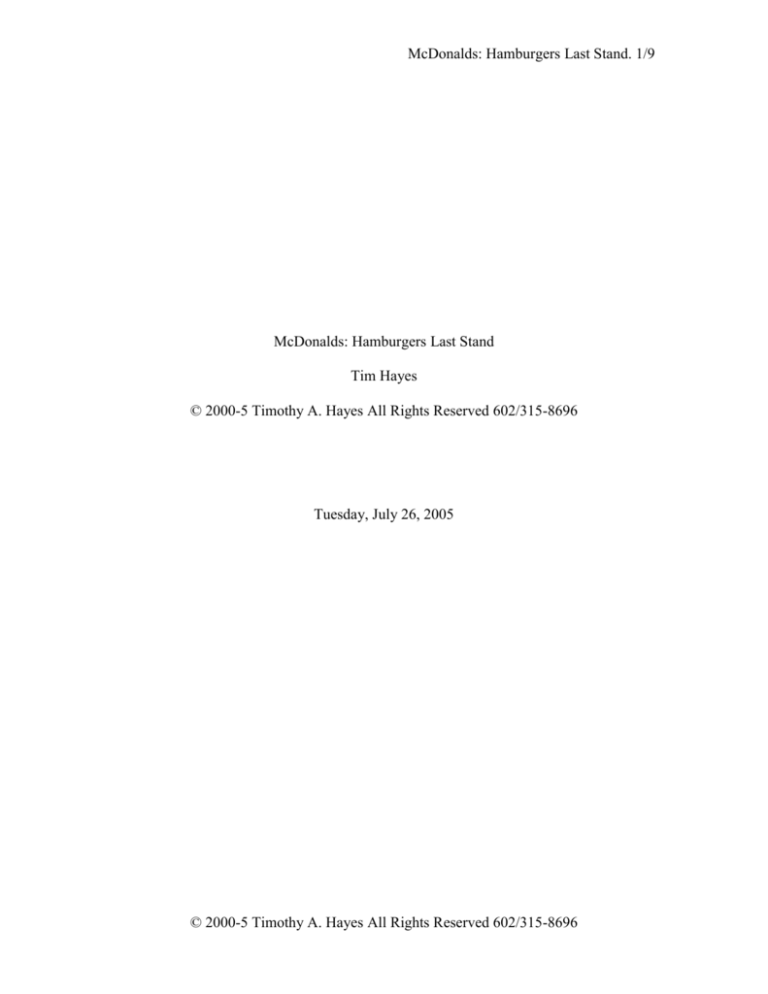
McDonalds: Hamburgers Last Stand. 1/9
McDonalds: Hamburgers Last Stand
Tim Hayes
© 2000-5 Timothy A. Hayes All Rights Reserved 602/315-8696
Tuesday, July 26, 2005
© 2000-5 Timothy A. Hayes All Rights Reserved 602/315-8696
McDonalds: Hamburgers Last Stand. 2/9
Introduction
McDonalds corporation faces several challenges including weak customer service
ratings, changes in consumer preferences towards healthier diets, and market saturation.
However, due to our land ownership policies, global market penetration, and stable
supply chain management and processes, we also have several offensive and defensive
opportunities as we move into the 21st century. In order to keep our foothold as the
dominant fast food provider several offensive changes must be considered in our
domestic and global strategy. These changes include better customer service, increased
responsiveness and change speed, capitalization on globalization, and finally, leveraging
of fixed assets for increased momentum.
Key Stakeholders and Value Chain
McDonalds has several stakeholders. First, since McDonalds is a public company,
our shareholders are key stakeholders. Second, McDonalds employees rely on us for
income and benefits. Third, local communities and consumers are stakeholders who rely
on McDonalds to provide fast, efficient, good food on a consistent basis.
Key Issues
There are several issues affecting the future success of our company. Although
our stock recovered in 2003 from the large decline in 2002, market indicators show that
this recovery was only a general recovery experienced by almost all restaurant chains of
similar nature. Since our stock performance trend falls neatly with the industry average
it means that our policies of 2003 were not integral in our success and recovery. It is
therefore imperative that we find other meaningful ways to continue our competitive
© 2000-5 Timothy A. Hayes All Rights Reserved 602/315-8696
McDonalds: Hamburgers Last Stand. 3/9
advantage and our place as the number one restaurant chain in the world. In fact, of
several important financial market indicators, we are only first in market cap (Table 1).
Table 1: McDonalds VS Industry Financial Indicators
Financial Indicator
Market
Capitalization
P/E Ratio
Revenue Growth
Return on Equity
Industry Leader
McDonalds
McDonalds
38.48 B
Rank
1 / 72
CMPP
DRMS
YUM
15.54
8%
18.45%
42/72
36/72
12/72
There are three primary revisions that must be made for us to compete in the next
decade. First, our business model needs to be altered to combat some critical
infrastructure weaknesses in customer service and brand loyalty. Second, we need to
leverage our fixed assets and processes to quickly expand into the global market before
others less established companies have the opportunity. Third, we need to develop
offensive strategies in our home market to compete with smaller, more responsive chains
who have successfully capitalized on both value and niche market strategies in the US.
Analysis
As a global leader in the restaurant industry with a huge inventory of appreciating
fixed and property assets, McDonalds corporation has some very promising strengths.
However, in a quickly changing competitive environment with differing consumer
preferences, disruptive technological innovation, and a saturated market, some of those
core competencies can quickly become weaknesses. When the weaknesses are
recognized by competing firms, they become threats and eventually we lose market share.
For example, a tremendous amount of effort and resources has been invested in
establishing a portfolio of fixed assets. However, if tastes and preferences change
quickly, then these investments may become obsolete and perhaps even dead weight and
© 2000-5 Timothy A. Hayes All Rights Reserved 602/315-8696
McDonalds: Hamburgers Last Stand. 4/9
allow smaller (or even new) chains who can move quicker due to less obsolete and older
assets to capitalize on the changing tastes and gain market share.
Strengths
McDonalds has several key strengths including processes, property ownership,
supply chain management, and tangent product sales. I believe we should abandoned
tangent product sales because it differs from our core competencies. Instead, we should
focus on transferring our processes to efficiently expand into the international market.
We can leverage our property ownership to create the financial backing to quickly
expand into the global markets before competitors have the opportunity for extensive
expansion. The property ownership model has stored a lot of momentum that should
now be released in order to continue growing. Currently our operating margins (18.54%
compared to Wendy’s 11.43%) and our Earnings-Per-Share (1.94 compared to Wendy’s
.49) tout our operating efficiency. However, investors have rewarded us with a much
lower Price-to-Earnings ratio as compared to other domestic chains showing that they
lack confidence in our continued performance. Now is the time to use the stored
financial resources for international expansion, and hopefully receive a vote of
confidence and an increased P/E ratio.
Weaknesses
McDonalds faces several weaknesses, two of which can be addressed internally
by better controls and training. The first is customer service. Since McDonalds is a
chain of closely related restaurants, the reputation of one is that of the many. Losing a
customer in one restaurant means losing a customer for the entire chain for life. We
should therefore spend more time and capital to train our mangers and employees for
© 2000-5 Timothy A. Hayes All Rights Reserved 602/315-8696
McDonalds: Hamburgers Last Stand. 5/9
customer satisfaction. Furthermore, we should make sure our menus and processes
allow for the greatest flexibility while maintaining a simple, structured business model.
We should eliminate complex meals or meals where resources are difficult to obtain or
maintain. This will alleviate employee mistakes and provide a more structured easy to
follow menu for customers.
The second weakness is changing consumer preferences. We need to develop
new menu items and eliminate menu items to quickly match changing consumer
preferences. We should continually monitor buying patterns and leverage technology
and information systems to setup international databases that monitor all sales traffic,
complaints, and suggestions in order to track preference changes and implement
defensive strategies on an almost real-time basis. Technological innovation should be
integral in our business strategy.
Finally, domestic Market saturation is both a weakness and a threat. Since
McDonalds is the largest competitor, it is hard to grow as a percent of total sales in a
saturated market. We cannot afford to focus on a niche market as some competitors do.
The best way to grow market is to continue to be the low priced value-added provider and
concentrate our efforts on expanding international operations. That is, Leverage
stagnated growth revenues in the domestic market for overseas growth.
Threats
The threats to McDonalds continued success are strongly linked to our
weaknesses. First, small, highly responsive chains such as In-N-Out can easily gain
niche market share on a local basis. Second, health initiatives have targeted our products
as unhealthy. Third, if our brand image collapses, other companies will capitalize on the
© 2000-5 Timothy A. Hayes All Rights Reserved 602/315-8696
McDonalds: Hamburgers Last Stand. 6/9
opportunity and take market share. In order to combat these threats, we need to maintain
a highly adaptable yet robust strategy. Even though we have huge investments in fixed
assets, we need to be willing to abandon or alter these assets to fit the consumer
preferences and the market. We can expect some companies to find niche markets where
we cannot compete, however, we should leverage our efficiency and distribution
channels to be the lowest cost provider and undercut these competitors. Second, we
should focus on customer service to ensure brand loyalty as previously mentioned.
Finally, we should continue to develop healthy recipes to capture to all sectors of
the market. It is possible that a domestic joint venture with a healthy products restraint
chain may give us increased credibility with health conscience consumers. Teaming up
for increased efficiency has been a fairly new strategy with some competitors such Pizza
Hut and Taco Bell. It may be beneficial to capitalize on a similar strategy to improve
both our brand image and efficiency.
Opportunities
We have several potential opportunities. The first, to alter our business model
and improve customer service, is more of a necessity than an opportunity. However, it
will provide the basis for competing in the domestic markets. The second opportunity,
quick global expansion, provides the most chance for growth and increased shareholder
wealth. We can leverage our assets, perhaps even with debt financing, to acquire the
necessary capital for a huge international expansion campaign. We currently have 20
billion in fixed assets, far more than any other competitor. These assets can be
mortgaged and the money used for international growth. It is imperative to the future
success of McDonalds that we maintain a first mover advantage in the international huge
© 2000-5 Timothy A. Hayes All Rights Reserved 602/315-8696
McDonalds: Hamburgers Last Stand. 7/9
market. The new market should provide a sustainable competitive advantage during the
next twenty years if not indefinitely.
Recommendation
McDonalds needs to focus on leveraging domestic sales to capitalize on the international
market. This will provide the needed expansion and growth to stay on top of the
restaurant business and increase shareholder wealth. One method of expansion is
to leverage the huge pool of built up domestic fixed and property assets (over $20
billion) to provide financing for international expansion. On the home-front,
McDonalds needs to alter its business model and menus to respond quickly to
consumer preference changes and improve customers service. This will help to
ensure stable profits in the domestic market and the ability to quickly defend
against competitor actions to take market share. The revenues from the domestic
market should also serve as a cash cow for international expansion.
© 2000-5 Timothy A. Hayes All Rights Reserved 602/315-8696
McDonalds: Hamburgers Last Stand. 8/9
Appendix
Table 2: Summary of Current Strengths
Processes
Strength
Property
Ownership
High
Level
Combined
Strength
Key Points
Supply Chain
Management
Very High
Tangent Products
High
Medium
-McDonalds
has a
sophisticated
supply chain
system
including
potatoes,
farming
techniques.
The system is
internationally
recognized.
-Extra income from
tangent products.
-This strength may
also be a weakness
if it spreads our core
competencies too
much.
High
-McDonalds
Processes,
efficiency of
operations, and
synchronization
is its core
competency
and basis for
success.
-A good decision
in the beginning
added strongly to
McDonalds assets
and return on
investments by
owning property
and renting the
land to
franchises.
Table 3: Summary of Current Opportunities
Opportunity
Improve customer
service for better
competition
Outlook
Combined
Weakness
Key Points
Always good
-We need to
lower our
turnover rate,
increase training,
and create a
corporate culture
of quality and
service. Losing
customers due to
poor customer
service is
unacceptable
Expand
international
market esp.
Asia
Very good
Leverage fixed
assets for
increase
working capital
Good
Good
-Large
international
markets are
the key to
continued
growth as the
US market is
saturated
-We have a
competitive
advantage over
many due to the
large volume of
fixed property
assets. Should
we need to
execute a cash
heavy
offensive, we
can leverage
these assets
Use offensive
strategies to beat
competition in US
market
Good
-We are losing share
in the US market due
mainly to smaller,
more responsive,
niche restaurants.
We need to develop
and execute offensive
strategies to develop
brand loyalty in the
US and international
markets.
© 2000-5 Timothy A. Hayes All Rights Reserved 602/315-8696
McDonalds: Hamburgers Last Stand. 9/9
Table 4: Summary of Current Weaknesses
Weakness
Level
Combined
Weakness
Key Points
Customer Service
Health Food Threat
to Core Competency
High
Market Saturation
Medium
High
Medium-Low
-Poor customer
service is a problem
that may lose brand
loyalty in the long
run
-General changes in
customer buy
patterns. This is only
a medium threat since
we may be able to
defend with healthier
products.
-Too many cooks spoil the
market. We need to find
ways to keep competitive
advantage in a fairly fixed
market with many
competitors.
Table 5: Summary of Current Threats
Threat
Threat
Level
Combined
Threat
Major
Players
Key Points
Small, highly
responsive chains
Very High
Niche chains
Health food
initiatives
High
Medium
Brand image
(customer service
and loyalty)
Medium-High
High
In-N-Out,
Wendy’s, Sonic
-Smaller chains
can respond to
changes in the
competitive
environment
more quickly.
They also have
less drag from
previous market
positions and
preferences
In-N-Out, Sonic,
healthy sandwich
shops
-Some chains
have developed
niche markets and
taken market
share away from
bigger companies.
For example,
Blimpies.
Buyers
Buyers
-Buyers, both
domestic and
international,
have differing
tastes and are
tending towards
more health
conscience food.
Foods which have
not historically
been a core
competency of
McDonalds.
-Losing a
customer due to
poor customer
service may be a
permanent
problem due to a
single incident.
These losses will
eventually
threaten overall
sales. Poor
customer service
at a single
franchise may
affect sales at all
franchises.
© 2000-5 Timothy A. Hayes All Rights Reserved 602/315-8696

